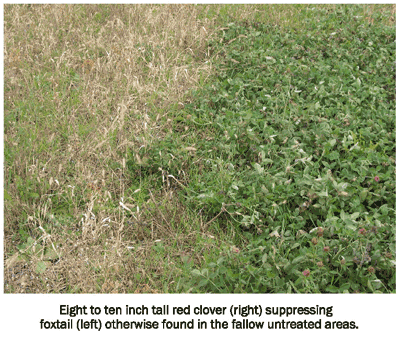After reading research from their local University of Wisconsin-Extension agent based in Winnebago County, Pete and Charlie Knigge decided to give frost seeding red clover into winter wheat a try. Last year, they added 10 pounds of red clover seed per acre when they applied urea in the spring. Urea was applied at 150 pounds per acre. They choose to apply with an airflow spreader (opposed to a box spreader) so they could get more even application. Not entirely convinced the double cropping system would work, the Omro, Wis., dairy operation purchased the cheapest red clover seed available.

The red clover had good germination rates, and timely rains helped get it off to a good start. However, by the time the wheat was harvested, it didn't look so good. That all changed a week after the harvest, "The red clover just took off," said Pete. "We estimate it yielded about 2 tons per acre. It made a great feed . . . the red clover was diluted with some wheat stubble, and it provided a good forage mix for our bred heifers. We green chopped it on a daily basis," he said. "The only change we will make is planting a little better variety of red clover which we will do this year."
The Knigges will no-till corn into the winter-wheat-red-clover field this year. As for nitrogen credits they can expect, previous research by the University of Wisconsin Nutrient and Pest Management Program estimates the red clover provided 50 to 80 pounds of nitrogen credits per acre. That research also shows that the Knigge yields were a bit higher than the 1.7-tons-per-acre yield average from the research trial. Fall forage yields had a wide range from .33 to 3.26 tons per acre and depended heavily on the weather.
For more on frost seeding, download the attached PDF from the University of Wisconsin Winnebago County Extension.

The red clover had good germination rates, and timely rains helped get it off to a good start. However, by the time the wheat was harvested, it didn't look so good. That all changed a week after the harvest, "The red clover just took off," said Pete. "We estimate it yielded about 2 tons per acre. It made a great feed . . . the red clover was diluted with some wheat stubble, and it provided a good forage mix for our bred heifers. We green chopped it on a daily basis," he said. "The only change we will make is planting a little better variety of red clover which we will do this year."
The Knigges will no-till corn into the winter-wheat-red-clover field this year. As for nitrogen credits they can expect, previous research by the University of Wisconsin Nutrient and Pest Management Program estimates the red clover provided 50 to 80 pounds of nitrogen credits per acre. That research also shows that the Knigge yields were a bit higher than the 1.7-tons-per-acre yield average from the research trial. Fall forage yields had a wide range from .33 to 3.26 tons per acre and depended heavily on the weather.
For more on frost seeding, download the attached PDF from the University of Wisconsin Winnebago County Extension.









